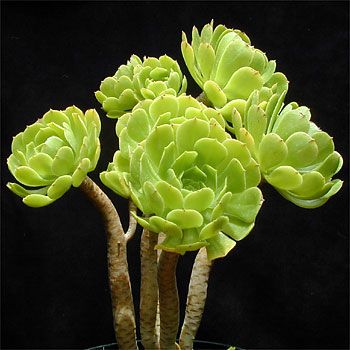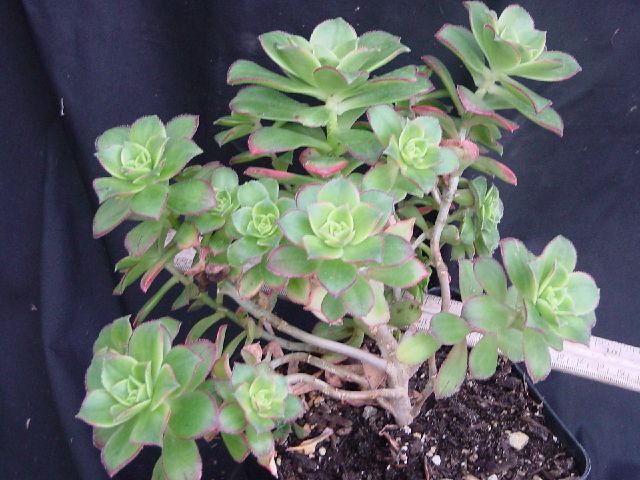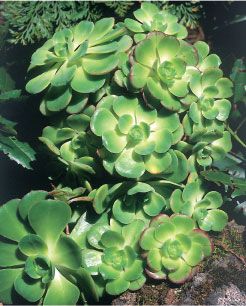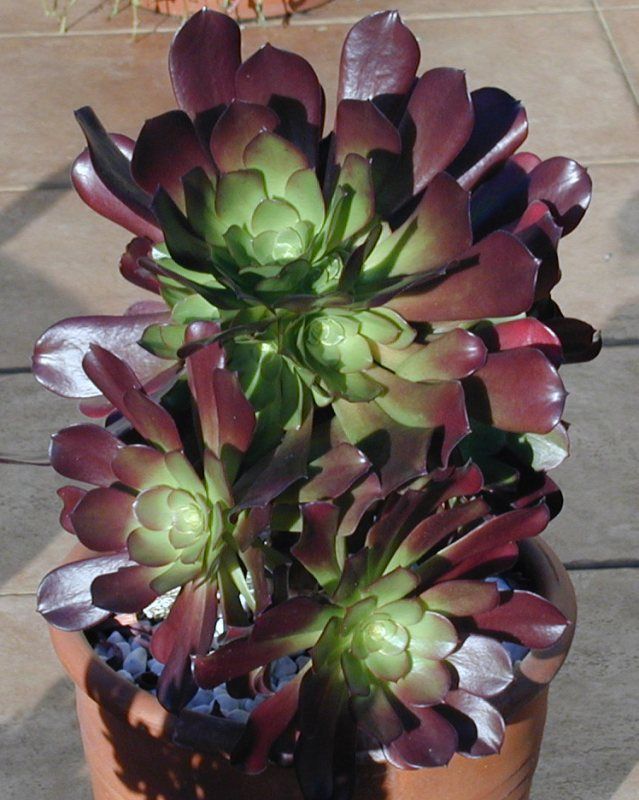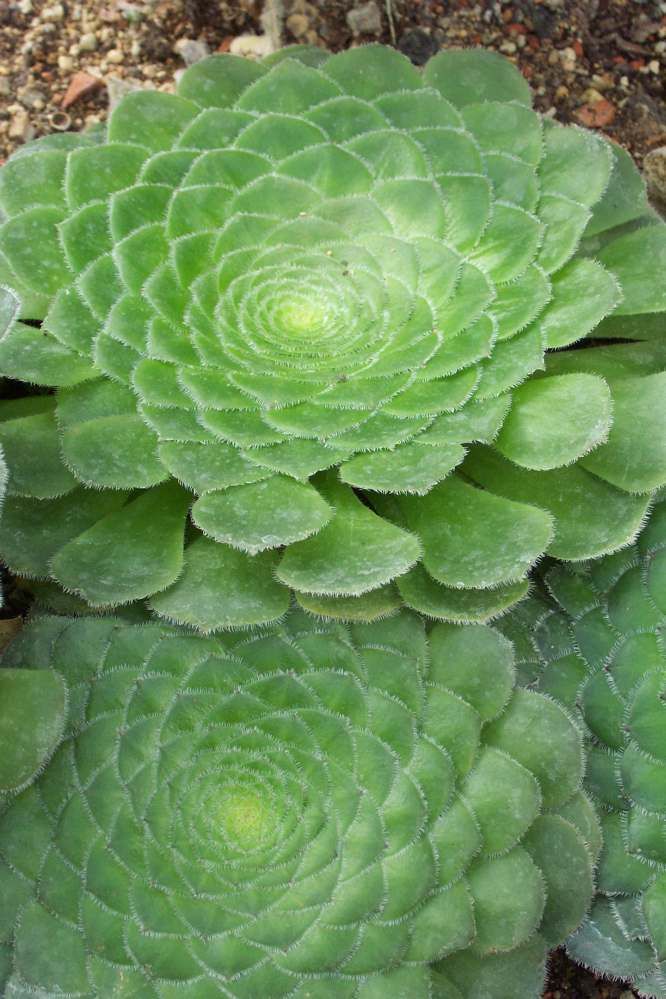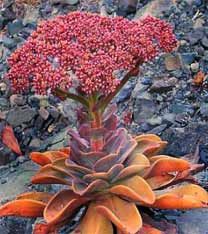Aeonium spp.
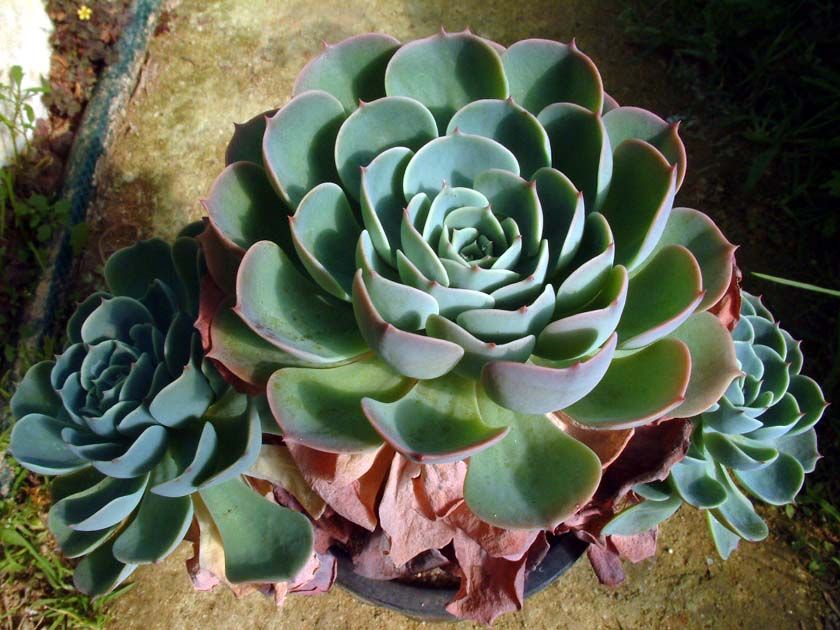
Family: Crassulaceae
Description
Aeonium succulents are native to the Canary Islands, North Africa and Madeira. They tend to form rosettes of leaves at the end of the leafless stem which takes on the appearance of a branch. Flowers are usually in the form of pendant racemes and are typically yellows.
Depending on the plant, and the species, the leaves can have attractive variegations.
Each rosette die after blooming and setting seeds. In some species, since the plants do not produce any offsets or side rosettes, it will die completely after blooming. These species are propagated by seeds.
Most species are fall and spring growers, and should be watered and fed regularly at these periods. Fall is also a good time for rooting cuttings. When the plants are getting older, it is often a good idea to cut and replant the terminal rosettes to prevent legginess. This has the added benefit of preventing the plant from reaching the size at which it will bloom.
|
|
|
|
Aeonium arboreum |
Aeonium nobile |
Care and cultivation
Coming from a Mediterranean climate, Aeonium spp. grow in the winter months. During the hot season they are dormant. This is unusual for succulents.
Temperature
In cultivation the daytime summer temperature should be kept between 20C - 30C and can be allowed to fall to 12C - 15C at night and 12C - 18C during the winter day and not less then 5C during the winter night.
The best way to keep during the summer is to grow them outside from May through September and place them in a sunny spot where they get maximum sunlight. From September through May they should be moved to a south facing window.
|
|
|
|
Aeonium gomerense |
Aeonium arboreum cv. Schwarzkopf |
Pot Type
Aeoniums are best grown in a terracotta type pot which should have at least one drainage hole in the base and it should be unglazed. This type of pot allows good drainage and allows the compost (therefor roots) to breath.
Compost
Aeonium prefer an rich and very free draining compost.
Watering
The plants should be kept almost completely dry during the winter months, only water them to prevent the roots from completely drying out, once a month should be fine.
Aeonium haworthia variagata
From March onwards the plant will begin to grow and watering should be increased gradually until late May when the plant should be in full growth. As the compost is very free draining and the pot used is porous you can safely water this type of cactus at least once a week during the summer so long as the plant pot is allowed to drain and not sit in a tray of water.
During hot weather you may need to water the plants once a day so long as the plant is actively growing. From late September watering should be reduced to force the plant to go in to a state of semi dormancy, by November you should be back in to the winter watering regime.
|
|
|
|
Aeonium tabuliforme |
Aeonium nobile |
Light
Grow aeoniums in bright sun during the summer and winter to avoid lush weak growth, strong sunlight will encourage the full colours of the leaves to develop.
Feeding
If the compost is fresh then feeding may not be necessary at all, if the plant hasn't been repotted recently then half strength general purpose fertilizer can be used at watering time from May onwards once a month. Do not feed the plants from September onwards as this can cause lush growth which can be fatal during the darker cold months.
Repotting
Repotting should be done every other year or every three years, annual potting is not necessary. Remove the plant from its pot by cradling the stem if it is very tall. Carefully tap it out of the pot and remove the old compost to examine the roots, if any are damaged or showing signs of rotting they should be removed as close to the plant as possible.Re plant it using the same mix of compost as it was originally in (fresh) and use a pot just slightly wider then the width of the plant. Do not be tempted to over pot as this will cause the unused compost to go stagnant and you may lose the plant.
Propagation
These plants are very easy to propagate from cuttings. Cut off a rosette and let it harden off for three days or more. Then the cutting can be placed directly into a well-drained mix to root.
Species and varieties
There are about 35 species of Aeonium . All but two are found in the islands of Macaronesia (particularly the Canary Islands), off the coast of North Africa in the Atlantic Ocean. A. arboreum is one of the two mainland species, growing in Morocco. The green-leaved form of the species, commonest in the wild, has been grown in Europe since 1727. There are some rare forms with maroon leaves ( A. arboreum f. atropurpureum ). Aeonium arboreum Schwartzkopf is an extremely dark clone of this form. When you buy this plant, make sure it is true, as some nurseries label all dark-leaved forms as Schwartzkopf. There are also variegated forms of this species, such as A. arboreum Island Sunset.
Other species of Aeonium vary in size, branching pattern, and color. In all species, the rosettes die after blooming. Therefore, a branching species will continue to grow after flowering, while single-headed species rely on seed only for their continued existence. This is similar to the situation in agaves. A. canariense has large (to 45 cm) rosettes of green leaves in a low, clumping plant. Its pyramids of yellow flowers are quite large. A. decorum has small (5 cm), chunky rosettes of red-edged leaves. These form clumps with several hundred heads, to 75 cm high. A. undulatum bears single, 35 cm rosettes atop a meter tall stem. A. tabuliforme has a single, stemless rosette; the leaves form a flat platter to 30 cm. All of the unbranched species are less common in cultivation, as they must be grown from seed.
Articole asemănătoare
-
17 plante recomandate pentru acasa si locul de munca
Oamenii iubesc plantele din varii motive dar, in general, pe primul plan sunt mirosul, culoarea, forma si functia lor decorativa. Ultimele studii ne-au demonstrat, totusi, ca la baza prieteniei dintre om si natura exista relatii mult mai complexe decat s-a crezut.
-
Plantele ornamentale si acarienii
Acarienii fac parte din clasa Arahnidelor, adica sunt rude mai apropiate paianjenilor si scoprionilor decat insectelor, in ciuda aparentei. Acestia traiesc aproape in orice tip de habitat: in desert, tundra, pe varfuri de munte, pe animale, oameni etc.
-
Parcul National Caldera de Taburiente, Insulele Canare
Avand un diametru de aproximativ 8 km si o circumferinta de 20 km, Caldera de Taburiente este una dintre cele mai spectaculoase forme de relief cu origine vulcanica de pe teritoriul Spaniei.
-
Arbustul Kumquat
Fortunella spp sau Kumquat este un arbust peren mic. Fructele sale sunt folosite ca decoratii sau conservate in siropuri si marmelade sau confiate. Sunt asemanatoare portocalelor mici, au coaja moale si subtire, aceasta fiind dulce si comestibila. Pulpa lor este acra.
-
Flori rosii pentru o gradina plina de pasiune
Culorile sunt foarte importante, fie ca le folosim pentru vestimentatie, pentru amenajarea interiorului sau in gradina. Cu totii stim sau avem cateva notiuni despre semnificatia fiecarei culori in parte: albastrul este o culoare care calmeaza, verdele revigoreaza si relaxeaza, galbenul ne face mai optimisti, rosul emana energie si pasiune, etc. Asadar, persoanele care doresc sa isi amenajeze gradina in functie de culorile florilor, pot opta pentru varianta care li se potriveste cel mai bine.
